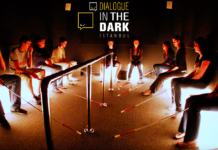SALT Beyoğlu will host the exhibition The Universe Flickers from Wednesday 12 September to Sunday 30 December. Borrowing its title from a chapter of Liu Cixin’s science fiction novel The Three Body Problem (2016), The Universe Flickers takes on the idea of alienation and reconfiguration by investigating the possible ways of recording or generating matter in transitory times when the very limits of language, registers, and representation of truth are severely tested. The artists address the limits of our knowledge, the infidelity of testimony, as well as the corruptibility of history through works that posit experiences with the unknowable and the inadequate image we have of the present.

From the Organizator:
How do you create a record or generate matter in transitory times when the very limits of language, registers, and representation of truth are severely tested? Borrowing its title from a chapter of Cixin Liu’s well-known science fiction novel’s English edition The Three-Body Problem (2014), The Universe Flickers takes on the idea of reconfiguration of history and future. When the book’s protagonist, seeing a set of numbers counting down before his eyes, proves that the universe was flickering, he transcends the limits of human experience and tests his understandings of the world. The exhibition delves into the possible ways of destabilizing our containment fields, our zones of comprehension, and the way in which one interprets the self within, when our earthly sense comes loose. Taking SALT Beyoğlu as a departure point, Anna Boghiguian, Rana Hamadeh, Navine G. Khan-Dossos, and Merve Ünsal tackle the unknowable and the inadequate image we have of the present with works stretching into, occupying, and animating the building.
The artists address the measures of our knowledge, the infidelity of testimony, as well as the corruptibility of history. Their practices, which are often influenced by the intellectual and critical impulses of feminism and queer theory, trouble the capacities and the limits of political representationalism. Boghiguian’s drawings and paintings operate as reflections on the geopolitical conditions in which her subjects live. Her images link antiquity, literature, myth, and poetry as she intends to describe the conditions of our current alienation. Hamadeh’s work is part of a long-term operatic project investigating the notion of testimonial in an attempt to disrupt the centrality of citizenship. Khan-Dossos responds to the 150 years-long history of Siniossoglou Apartment, today SALT Beyoğlu, by murals reminding the building’s original use of space as retail on street level and domestic residences on its upper floors. Referencing the existing ceiling paintings, the artist’s light wash monochromatic murals propose that the private domain can be just as much a place of crime or incident as the public space. Ünsal negotiates the thresholds of dwellings through positioning them in stark dualities, always in relation to herself as an aural and visual voyeur. By creating protagonists of architectural buildings, human subjects become occupiers, while the artist extrapolates on that position of being “inside,” literally and metaphorically.
The Universe Flickers aims to invent and name the future that is to come in times when the definitions of subjecthood, sovereignty, gender, kinship, and technology are being recomposed. Spreading across SALT Beyoğlu, the four positions proposed by artists produce a series of complex affects while triggering sensibilities, which effect both habits of the body as well as the habits of the mind. Instead of de-facto series of art objects on show, the works are spatial interventions, even performative challenges to classic dynamics of exhibition display.
For more information, be sure to check out the official page.










